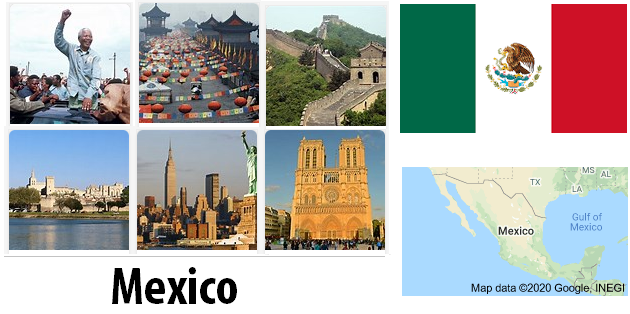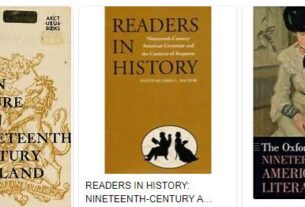Mexico is said to have been explored in the 5th century by Hoein Scin, a Chinese Buddhist priest. Archaeological discoveries would confirm this belief. The structure and decoration of the ancient temples of Palenque and Mitla, the many statues of divinities and priests that came to light, the miniatures of certain manuscripts and even some place names, would constitute valid evidence of the Buddhist influence in the country, which was the most ancient seat of the American civilization.
Before the Spanish conquest, three great civilizations had taken turns in Mexico and nearby lands: those of the Toltecs, the Mayans and the Aztecs.
These ancient peoples had many customs in common, first of all that of building grandiose pyramids with long stairways leading to the top; here there was a large open space where the altar dominated on which the victims were sacrificed to the gods, the main of whom, with various names depending on the people, represented the Sun and the Moon.
The construction of the buildings took place in fixed periods: certainly every 52 years. These peoples believed, in fact, that after this period of time the world should end, and they trusted the priests so that they could continue life on earth. This belief of the people greatly increased the power of the priests who, together with the nobles, were the absolute masters of everything. Solid and comfortable dwellings built on hills, while the wooden houses of the people extended below.
The tributes that the people had to pay were very strong; also the people had to provide with their work to build the houses of the nobles and temples for the gods.
It has never been established how long the civilization of these peoples lasted. Some scholars have claimed that it began 8,000 years ago. If true, it could be said that it is even older than the Chinese and the Egyptian ones.
Before abandoning Mexico and taking refuge in the Yucatan Peninsula, the Toltecs completely covered some of their cities with earth. Even just from this burial work you can get an idea of their great organization.
In fact, it was a matter of filling the earth and completely submerging buildings that sometimes reached 40 meters in height, as in the case of some pyramids with characteristic stairways.
A curious custom of the Maya was the abandonment of cities. After a number of years, the Mayans left their homes, temples, streets and squares in their cities without taking anything away and emigrated en masse to distant lands. Upon reaching the new headquarters, construction of new homes began.
In the abandoned city herbs and plants grew gradually and over the centuries the vegetation completely submerged them. Some modern explorers discovered ancient Mayan cities in the midst of almost impenetrable forests. Scholars have not been able to explain these strange migrations.
The most acceptable explanation of this periodic transmigration phenomenon is the following: the ancient Maya, although very civilized, did not know a simple but very useful tool for the true development of civilization: the plow. To cultivate the land, they pierced the ground with the stakes and introduced the seed into it. The plant that was usually corn was growing, but the undeveloped soil impoverished and the farmers had to move further and further away from their homes every year to look for new fields to grow.
Over the decades, the distance between crops and the city became excessive; it was therefore necessary to move to new lands and build a new city.
The Mayan calendar was calculated on the observation of the motion of the stars. The year was 365 days: the months were 13 and each included 20 days. There were 5 days left to complete the vintage cycle. The signs that represented the numbers, days and months were regularly reproduced on the facades, columns and obelisks of the temples.
The temples and obelisks of the Maya were adorned with very strange sculptures; human faces and figures were deformed and looked like monsters; there were also dragons and birds, but above all impressive was the figure of the feathered snake, which was not missing in any large building, because it was the symbol of a divinity.
At the time of the Spanish conquest, the Aztec empire was well organized and powerful. They knew how to make paper out of agave fibers, melted metals, woven fabrics and tanned leathers. Their public buildings were lined with stones and adorned with mosaics and sculptures.
The Aztecs were very religious: they worshiped numerous deities, including Huitzlochtli and Quetzalcoatl. Their religious rites, however, were bloody and cruel. Human victims were killed mercilessly to offer their throbbing hearts to the gods. In a building near an Aztec temple, the Spanish conquerors found 136,000 skulls of human victims sacrificed to the gods.
Since 1160 the Aztecs settled in the Mexico area. They founded their capital in 1325. Their first king Acampichtli, ascended the throne in 1376. He had twelve successors: the last was Guatimozin.
After the arrival of the Spaniards, the Aztec civilization declined rapidly. The pagan temples were torn down, or abandoned or transformed into Christian churches. All the sacred books and precious documents of their civilization were burned at the stake by order of the religious and civil authorities of Spain. Today only the ruins of the ancient temples testify to the high level of civilization reached by this people.
When the Spaniards of Cortez, in 1519, the conquest of Mexico began, they believed they had to cross a wild and uncivilized country. But they soon realized that they had arrived in a country of great civilization. As they marched through Mexican territory, instead of encountering hut villages, they saw big cities. Above all, Bella was the capital city of Mexico City, built in a lake area and crossed by canals, such as Venice. The city had large gardens and grandiose buildings. At the center of it was the Teocalli (house of the god), a large temple with large stairways and countless sculptures. Mexico City then had 65,000 homes.
On the morning of April 22, 1519, 11 Spanish sailing ships from Cuba appeared off the Atlantic coast of Mexico. Several lifeboats broke away from the sailing ships and took land a little north of the place where the city of Vera Cruz is now located. On the deserted beach 553 soldiers gathered, 110 sailors, 16 horses, and 10 cannons and 4 colubrines were dragged to the shore. A young man, in the uniform of a general captain, directed the landing. That man was Fernando Cortez, a Spanish nobleman, who thus began one of the greatest enterprises of those times: the conquest of the mysterious kingdom of the Aztecs.
Until a few years earlier, Europeans believed that America’s lands were inhabited only by savage tribes. Instead, in 1518, the Spaniard Giovanni de Grijalva, exploring the interior of Mexico, had narrated that he had seen, among the boundless forests of the territory, colossal temples and cities hidden in the mountains.
These works showed the existence of a highly advanced people. And so Cortez, who was in America to try his luck, thought that his time had come: he set up an expedition, with the aim of conquering that fabulous kingdom. Above all, he hoped to get his hands on the immense wealth of the Aztecs.
On the morning of August 16, and until November 10 of the same year, the Spaniards’ column advanced slowly, between forests and swamps, fighting against tribes of Indios. At dawn on November 8, in a valley in the mountains, on the banks of a lake, the capital appeared: Tenochtitlan (Mexico City).
The Spaniards, with arms in hand, followed Cortez. After passing the dam that led to the city, they passed over a large drawbridge. They were now in the capital of the Aztecs, the city where the gods were honored by killing humans on the altars. A procession of men met them on the great central street of the city. Carried on a sedan chair sprinkled with precious stones and framed in silver, a tall, pale man with long black hair advanced. He wore a cape embroidered with pearls and precious stones and wore gold sandals. It was Montezuma II, Emperor of the Aztecs. He welcomed the Spaniards without hostility.
Montezuma, with his one hundred thousand warriors, cruel and well armed, could have exterminated that small group of Spaniards: but he did not do so because he remembered a prophecy of the god Quetzalcoatl, who had heralded the arrival of invaders from afar and was afraid of commit a sacrilege by massacring them.
For a year Cortez and his men were thus able to remain in the Aztec capital. But the people and generals hated these foreigners. A year later they rebelled against the Spaniards and killed Montezuma who urged them to lay down their weapons. His successor, Guatimozin, in agreement with the people, fought fiercely to drive out the Spaniards; but he was defeated and Cortez had him hanged.
Thus in the year 1520 the fabulous reign of the Aztecs ended and Spain took possession of the whole of Mexico.
In 1522 Emperor Charles V, king of Spain, appointed Cortez governor and captain general of the whole recently conquered territory, a position he held until 1527, when he was appointed Marquis and then set aside. In fact, in that year the governor was replaced by a 5-member council called “Audiencia”.
As soon as the conquest was complete Cortez granted his followers the ownership of vast lands and the “encomiendas”, that is, the right to have indigenous people at their service. The “encomenderos”, that is, the Spanish colonists, had to convert, educate and protect the natives; but in reality they became their exploiters: in fact they forced them to pay heavy taxes and practically treated them as slaves.
Slavery was then officially condemned with the “Liberty Bubble”, issued in 1536 by Pope Paul III and the “encomiendas” were publicly abolished by Viceroy Mendoza in 1542. (This law, however, had to be withdrawn, because the colonizers threatened a Other laws published subsequently did not have any effect and in practice the definitive abolition of the “encomiendas” took place only after two centuries, in 1729).
The first “Audiencia”, chaired by Nuno de Guzman, stripped many of the conqueror’s followers from their possessions to give them to their sympathizers.
In 1530 a new “Audiencia” was appointed, presided over by Bishop Ramirez del Fuenleal. It governed the country well and remained in power until 1535, when a Viceroy, Don Antonio de Mendoza, was sent to govern Mexico, who remained in office for 15 years, ruling with great wisdom. Antonio de Mendoza is worthy of appearing, together with Cortez, as founder of New Spain. (Cortez died on December 2, 1547 at 62 years old and his body remained in the land he had conquered as his ashes were walled in the chapel of a hospital in Mexico City).
The Viceroys of New Spain (from 1535 until the proclamation of Independence) were 62; they had great power and their authority extended not only over the current territory of Mexico, but also to the Philippines and the North American territories (California, Texas, etc.), which today belong to the United States.
The period of Spanish domination was, on the whole, quite favorable for Mexico. With the same rapidity with which they had conquered the great empire, the Spaniards began its colonization.
They imported some animals from Europe (such as horse, ox and sheep) and some plants (wheat, rice, citrus fruits), which soon spread rapidly. Other Mexican products (mainly cocoa and tobacco) were instead constantly imported into Europe.
Spain mainly exploited the wealth of the Mexican subsoil, especially silver, in whose mines worked thousands of indigenous people. The Spaniards spread the Christian religion and the Spanish language among the indigenous peoples of Mexico. The Franciscans, Dominicans and Jesuits founded numerous schools, churches and hospitals in New Spain. At the religious schools the natives also learned the arts and crafts.
The advance of the conquest, however, started by Nuno de Guzman, was continued by Francisco Vasquez de Coronato who, on behalf of the viceroy Antonio de Mendoza, continued the exploration from 1540 to 1542, which started from Compostela and arrived through the Rocky Mountains, up to Kansas.
Meanwhile other explorers, missionaries, miners and shepherds continued the journey towards the interior of the territory; they founded other cities such as Zacatecas and Durango, thus opening the way for expeditions.
In 1582/83 Antonio de Espejo went to New Mexico; colonization began on behalf of the second Viceroy Luigi de Velasco; however, the work was completed by Giovanni de Onate who in 1596 reached Kansas and founded the first colonies in the years from 1596 to 1608.
De Velasco immediately abolished slavery and, since the Crown of Spain had ordered that the properties not only of the colonists but also those of the natives be respected, provided that they cultivated them, he worked in this sense by every means and also made their progress Christianization, their participation in the exploration and expansion of the colonies, as well as the development of European culture, with greater union with neighboring populations. See Countryaah for population and country facts about Mexico. And with this the unions between Spaniards and Indians multiplied, with a consequent increase in mixed breeds, to which the Negro race contributed in a minimal part. Those born from these unions, the mestizos, were always considered inferior to the Spaniards and did not enjoy good positions. Even the Creoles were not satisfied with how the Spaniards were always preferred.
In the meantime, Christianity developed greatly in the center and south of the country thanks to the Franciscan, Dominican and Augustinian friars, to whom the latter were mainly responsible for the foundation of many colleges and libraries. In the north and north-west, on the other hand, the Jesuits mainly worked, who founded the College of San Pietro and Paolo in 1573 and from which the most important secondary and higher education centers in all of New Spain depended, from which the higher social categories with the greatest economic interests.
These categories often clashed with the orders of the King of Spain when they were deemed to be damaging to their rights, but everything fell into the order since priority was given to the prevailing interests of public life.
In 1729 the “encomiendas” were abolished and the king appointed, through the “Council for the Indies”, the high officials also in the ecclesiastical field. The Viceroys held the position for 6 years, sometimes even less, or at most for 10 years. Each time a Viceroy, at the end of the mandate, sent reports with all the economic and administrative data to his successor to inform him about the state of health of the country. If this was not satisfactory, a special “Juicio de Residencia” would meet to establish personal responsibilities.
Two were the “Audiencias”, that of Mexico and the secondary one of Guadalajara, which helped the Viceroy in his functions and replaced him during the holidays.
The state of inferiority, already mentioned, of the mestizos, the Creoles and the Indians compared to the Spaniards, began to create some problems. Yet the colony in 1767 was thriving; natural products were abundant, beautiful cities, numerous public buildings; the prized churches, the stately homes, the generous hospitality of the people, the life of the owners of the mines and the sumptuous landowners, the literary competitions held on the occasion of the numerous festivities, everything was to demonstrate the high degree of development of the country.
This was the picture of the situation when suddenly on June 23, 1767 the Jesuits were expelled from Mexico by the express will of the Enlightening Bourbon monarchy, then prevailing. The indignation of the colonists was of no avail. And this fact contributed to forming the already latent Mexican national consciousness in some literary works of that period, also written by a nun Giovanna Inez de la Cruz.
.
The expelled Jesuits were replaced by the Dominicans and the Franciscans who founded the missions, around which villages sprang up almost everywhere.
In the meantime, however, the internal government of the colony had been changed; the system of Intendenze was introduced, which was 12; the government of each was decentralized more within the country, especially in the north, but to centralize it, instead, in relations with Spain. These variations were the result of ordinances established in 1786 by Giuseppe de Galvez, who had visited New Spain a few years earlier. This organization was undoubtedly aimed at protecting and increasing the interests of Spain and certainly not for the benefit of the Mexicans who thus saw their discontent increase.
An ordinance in particular decreed that in every Indian country, the delegate should be “necessarily Spanish” and this decreed the discontent not only of the Creoles but of the whole population whose classes, aware of the inequalities existing between them, instead wished, with everything their spirit, to a just equality.
But everyone indiscriminately recognized in the organism of the Intendencies, the king’s powerful hand and submitted to it until, suddenly, Spain was left without a king, because it was defeated by Napoleon.
In the Napoleonic period, when Spain was invaded by the French, many colonies refused to obey the new king Joseph Bonaparte, Napoleon’s brother.
On September 12, 1808 Michele Hidalgo, parish priest of a Mexican village, called his natives to gather with the cry of “Long live independence” and started the revolution. Soon he was at the head of 80,000 indigenous people, to whom he promised the lands of the whites. The revolt, however, was stifled and ten months later Michele Hidalgo was shot.
The revolution was continued by another mestizo priest Giuseppe Maria Morelos. He fought five years against government troops by winning several battles, but eventually fell prisoner and was shot on December 22, 1815. The people’s revolution continued under the leadership of other leaders, including Vicente Guerrero and Agostino de Iturbide. The latter proclaimed Mexico’s independence on February 24, 1821 and on September 27 of the same year occupied the capital.
In 1822 Iturbide was elected Emperor with the name of Augustine I. General Antonio Lopez de Santa Ana rose up against him, who on October 4, 1824 gave Mexico a new Constitution, similar to that of the United States.
In 1825 Spain withdrew its troops from Mexico (but only in 1836 did it recognize the new state).
After the proclamation of independence there followed a long period of unrest and struggles between the various parties. From 1821 to 1857
Mexico had 6 forms of government, 55 ministries and 250 insurrections.
At that time, the Texas uprising occurred. The planters of that area had refused to obey a law enacted in 1835 that granted liberty to the Negroes. In 1836 they declared their independence and in 1845 they asked for annexation to the United States. From this fact arose a war between Mexico and the North American Confederation.
The war ended in 1848. In the Guadalupe Hidalgo Peace Treaty of February 2, 1848 Mexico ceded New Mexico and California (i.e. 1,338,000 sq km of territory) to the United States and received the modest allowance of $ 18 million. Another 116,000 sq. Km of Mexican lands were sold to the United States in 1853 for 10 million dollars. The boundaries then drawn are those that still divide the two states.
In 1857 a new Constitution was proclaimed and in 1858 Benito Juarez came to power, as President of the Supreme Court.
A pure-blooded Indian lawyer, he had started as a boy, first to ecclesiastical studies and then to legal studies. In 1847 he had been Governor of the State of Oaxaca, then, in 1853, Minister of Finance, strongly opposed by the conservatives.
He set about launching some important reforms such as the separation of the Church from the state, civil marriage, the nationalization of ecclesiastical goods, but he had to fight against multiple difficulties.
The policy of this president, contrary to the interests of the great European states, provoked the intervention of some nations (France, England and Spain). On June 7, 1863, French troops occupied the capital. A year later, on June 12, 1864, Maximilian of Austria became Emperor of Mexico, under the protection of the French. In 1867, however, the French troops were withdrawn and the Mexicans, led by Porfirio Diaz, rose up and captured the emperor. On June 14, 1867, the Martial Court sentenced him to death. The execution took place on June 19, despite protests from around the civilized world.
In 1871 Benito Juarez was re-elected president, who died the following year.
After a very tormented presidency of his successor, Sebastiano Lerdo de Tejada, a continuator of his anti-clerical policy, in 1876 Porfirio Diaz was elected who imposed the dictatorship and remained in power until 1911.
He reorganized the country and gave great development to agriculture, industry and communications. He defeated political anarchy and brigandage and indeed from the ranks of these he drew the police forces, called “Rural”, who were able to guarantee public order and the peaceful development of the country. He healed finances by creating the “Banco Nacional”, built railways and favored oil production.
His governmental machine was called “for the rich” because the lower classes got nothing from this progress. For the Indians, a state of servitude and illiteracy and wandering especially persisted; there was no sense of family stability. Many financial problems were also reborn in the country; mining, and especially oil ownership, were still in the hands of foreigners; 2/3 belonged to the United States.




